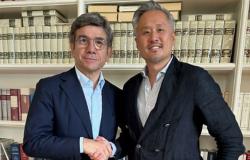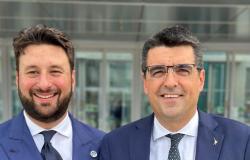Founded by a prince in 1635, it is one of the most recent municipalities on the island. Two illustrious brothers-in-law lived here, one a writer and the other a Nobel Prize winner for Literature
Preparations are underway in Acquaviva Platani for the eighth edition of the “Breccialfiorata” in honor of Corpus Domini which will liven up the historic center with original and colorful panels of sacred art. An initiative that involves almost the entire resident population. Not that there are many residents now, reduced to less than a thousand, compared, however, to several thousand Acquavivesi who live and prosper in the large communities of Forbac, in France, and in Wooking, in England.
Many of them have made fortunes. Suffice it to mention, just as an example, Joe Ricotta who in his renowned London restaurant “Nonna’s kitchen” has even hosted Hollywood stars such as John Travolta or Sylvester Stallone and the stars, full of good traditional Sicilian food, then lent themselves well for souvenir photos.
Welcome to Acquaviva Platani, a rural village in the province of Caltanissetta, but easily reachable from the SS 189 Palermo-Agrigento, where, precisely to remember the drama of a people who have had to look for their future in other places, a original, yet little known, Emigration museum.
Adv
The museum is divided into three macro areas: “The causes of emigration”, or the lack of work with the closure of the sulfur mines and the agricultural crisis; “The departure”, with the purchase of tickets even for large ships towards the American dream starting from the end of the 19th century; “Work abroad”, the last area, where you can view the most emotional part, such as the correspondence of emigrants with their family members who remained in Acquaviva.
The museum is enhanced by large wall panels that reproduce original documents but also by many memorabilia such as cardboard suitcases tied with string and much more.
Since last year, a museum of sacred images has also been set up to expand the tourist-cultural offering. These images, collected during his life as a collector by Dr. Mario Siracusa, were donated to the community. Among these also hundreds of paintings that our grandparents and great-grandparents kept in their homes, such as bedside of the double bed.
In the museum you can also admire many holy cards forming part of Doctor Siracusa’s collections and which in the past contributed to organizing the exhibitions “The Patron Saints of Sicily” and “The thousand faces and names of Mary”, a two thousand year long historical excursus on the figure of Madonna to discover absolutely original and truthful titles, such as the “Madonna of the slap”, the “Madonna of confusion”, the “Madonna with horns”, the “Madonna of sweat”, the “Madonna of patience”, the “Madonna of tickling ” and we could continue for a long time.
About the Breccialfiorataalso an innovative idea born in 2014, differs from the much better known ones adorned with flowers (characterized by the use of fresh flowers), for the use of colored breccia and artistically glued onto panels which are then enriched by fabric flowers and various compositions.
Months and months of voluntary and passionate work to set up the grandiose panels positioned right in the town centre, a perfect location given the sloping streets of Acquaviva, to offer a textbook view to those arriving from outside.
But this small hilltop village is also famous in literature with a capital L. In fact, they lived here Elio Vittorini and the Nobel Prize for Literature, Salvatore Quasimodo.
In “Conversations in Sicily”, his best-known work, Vittorini, who had lived here with his roadman father, writes: «And I thought of Acquaviva far away in space, a solitude at the mouth of the mountain… and my mother said that it was a terrible summer and that it was a terrible summer meant not a shadow for all those kilometers, the cicadas burst in the sun, the snails emptied by the sun, everything in the world became sun.”
Also his brother-in-law, Salvatore Quasimodo, Nobel Prize for literature in 1959, as a boy he lived in Acquaviva Platani, between 1912 and 1913, in the building of the small railway station following his railwayman father. Thus Quasimodo immortalizes Acquaviva in the literary Olympus with the lyric “What do you want, shepherd of air?”.
«And it is still the call of the ancient shepherds’ horn, harsh on the white ditches of snakes’ bark. Perhaps it breathes from the plateaus of Acquaviva, where Plàtani rolls shells under the water between the feet of the olive-skinned children.”
In short, the tourist who decides to spend a different weekend diving into rural Sicily will perhaps also be interested in knowing that with its almost 390 years, Living Water it is among the municipalities younger of Sicily. It was founded in 1635 by Don Francesco Spadafora who was granted the license to “inhabit” his barony of Caccione and Michinese located in the Val di Mazara by the viceroy Ferdinando Afan de Ribera, Duke of Alcalà.
The town owes its name to the Duke of Alcalà due to the notable presence of spring waters and the proximity of the Platani river.
The historian Father Giannino writes again: «One day the prince was riding around his fiefdom and the employees pointed out the nearest springs to him, because he had a certain project in mind. Now he could know how much water there was in the reservoir that had been passed down in his family for two hundred years, because wherever it was dug, pools of clear, living water came out.
How much water! How much water! she said to the princess in the evening. Let’s call Living Water our village. Do you like this name Donna Lucrezia? And the princess with a smile: this name is truly beautiful! We call the new land Acqua Viva. It will be a name for everyone. And so later, the Duke of Alcalà had it written on the parchment: we want the same Earth to be named and called Living Water.”
A auspicious name which among its fellow citizens also boasts a heroic carabiniere, Giuseppe Plado Mosca, Gold Medal for Military Valor, after whom the city barracks was named.
The history of this village is meticulously reconstructed in the books of Father Alfonso Giannino, author of fundamental texts such as “Acquaviva Platani in the history of Sicily and in national life” and “Civiltà acquavivesi-essays of cultural anthropology”, the latter published by the administration municipal on the occasion of the city’s 350th birthday.
A history that unfolds in less than four centuries, in short, but the territory of Acquaviva has been inhabited since ancient times, as evidenced by the Neolithic crouching tombs in the Vignazze district, which were destroyed in the past decades.
Father Giannino writes about these tombs: «They were carved in a rectangle on blocks of limestone, for a length shorter than the normal length of a man. The curling up of the still warm corpse avoided a long excavation work in the limestone, carried out with harder stone, generally siliceous”.
Caves and small caves with smooth interiors, further evidence of prehistoric tombs, can still be found in the districts of Acquaviva. In the Santa Margherita district there is a “tholos” tomb, with a rectangular opening and a recess to fit the foldable stone slab.
The crouching caves date back to around 1400 years before Christ, or 3,400 years ago. Traces of subsequent civilizations (Greek, Roman, Byzantine) testify to the presence of these peoples in the territory of present-day Acquaviva.






